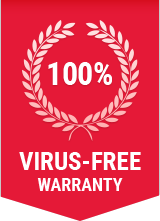What is HOSTID.EXE?
Originally developed by IBM Inc. HOSTID.EXE is a legitimate file process and also called as Host id Application that is associated with software OS/2 Warp. It is located in C:\Program Files by default.
HOSTID.EXE virus is created when malware authors write virus files and name them after HOSTID.EXE with an aim to spread virus on the internet.
Affected Platform: Windows OS
How to check if your computer is infected with HOSTID.EXE malware?
If your system is affected by HOSTID.EXE malware, you will notice one or the several below symptoms:
- HOSTID.EXE occupies an unusually large CPU memory
- Erratic internet connection
- Your browser is bombarded with annoying popup ads
- Computer screen freezes
- PC's processing speed suffers
- You are redirected to unknown websites
To pinpoint the virus file location, take the following steps:
Step 1: Press CTRL+ALT+DEL keys at once to open Task Manager.
Step 2: If you notice the file located outside C:\Program Files you should run an antivirus scan to get rid of the malware.
How to remove HOSTID.EXE malware from system using Comodo Cleaning Essentials?
You can either choose to remove HOSTID.EXE and other malwares using Comodo Antivirus, or Comodo Cleaning Essentials (CCE) – both of which are absolutely free to download! CCE is a set of computer security tools designed to help you identify and remove malwares and unsafe processes from an infected computer.
To remove malwares using CCE, take the following steps:
1. Check the system requirements and download the feature-rich CCE suite for free.
2. After installation, choose the type of scan you want to perform. CCE offers 3 scan options to get rid of malwares from a PC:
- Smart Scan: Does a scan on critical areas of your system.
- Full Scan: Does a complete scan of your system.
- Custom Scan: Does a scan only on selected items.
The process to initiate the above mentioned scans are self-explanatory and thus, easy-to-use.
Additionally, it's recommended that you approve of any updates that the CCE will prompt you about to ensure it does a better job of identifying all the latest threats.
3. Click 'Next' to view the results.
Regardless of the type of scan you choose, the results will sometimes show false positive (flagging files that are actually safe), which has to be ignored. Only select the files you want to get rid of.
4. Click 'Apply' to apply the selected operations to the threats. The selected operations will be applied.
| No. | Company | File Type | SHA1 | MD5 | Malware Name |
Digitally Signed |
File Version |
Product Version |
Submitted From |
Malware Behavior |
|---|
- 4 items per page
- 8 items per page
- 16 items per page
- 32 items per page
| No. | Company | File Type | SHA1 | MD5 | Digitally Signed |
File Version |
Product Version |
Submitted From |
|---|---|---|---|---|---|---|---|---|
| 1 | N/A | Executable | 48fcacc535c74a98 fc69ba2575751939 f82c8f5b |
19267dea19799945 bd1808ebaa1b2602 |
No | N/A | N/A |  United States United States |
| 2 | N/A | Executable | f60a031ddeaa4e1c e46a52eb6180861b 1ec8ab55 |
3f558850dfc65b59 660c91daa5b506e4 |
No | N/A | N/A |  104.238.128.144/32 104.238.128.144/32 |
| 3 | N/A | Executable | c08f53caefe6b74c e6ea024e53e11c5c cc79e240 |
0b9334c2dbed4de7 f4b0446912118ef5 |
No | N/A | N/A |  United States United States |
| 4 | N/A | Executable | 271ccc84af69105e 37405e4d40fa3162 e8946d07 |
630142ef3b9c35ab 012d8a0ac7d99d98 |
No | N/A | N/A |  United States United States |








